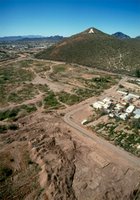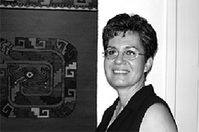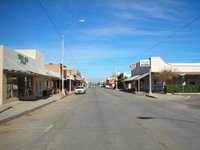[Source: Preston McConkie, Casa Grande Valley Newspapers] -- A trio of investors and owners of three established downtown businesses are steaming full ahead with plans that are transforming the look of Coolidge Avenue, though their enthusiasm has been slightly blunted by the first encounter with the slow machine of government and may be brought to a screeching halt by a city advisory committee. Phil Lingelbach and his wife, Linda Henderson, along with their partner Claudine Solansky, have purchased six buildings in the 200 block of the decayed avenue and are negotiating to buy three more. One building has already been renovated and sold.
Lingelbach said he has discovered Coolidge and believes it is time for its downtown to rise again. A little over a year ago he and Henderson bought the Sage & Sand Bar but soon shut it down and sold it at a healthy profit to a commercial developer who is replacing it with a retail center. "There just needed to be something else there," Lingelbach said. With the proceeds from that and other ventures, he next turned his sights on what was once a flourishing business sector where people came to shop for clothes, buy pastries, and play pool.
Lingelbach enlisted the aid of Economic Development Director Alton Bruce and Senior Building Inspector James Myers and toured the 200 block of Coolidge Avenue, with a particular interest in a green two-story building that had possibilities to be both a business and an apartment. Advised that the building had structural problems, Lingelbach instead purchased a small building next to the Main Street Park and began renovating it "as a place for us to come stay in town." The former bar owner said, "Right now there's no place to just come and sit - other than the bars."
Inside the building at 225 W. Coolidge Ave. he put in new drywall, a new ceiling and carpet and hung ceiling fan lights. Outside, he knocked out the old front that came right to the sidewalk and built a recessed area with home-style windows with blinds, put in an etched-glass door and bolted a steel-framed wooden bench to the walk. For a week Lingelbach was able to sit there and contemplate his plans for the rest of the avenue. Now he has sold the building to an occupant, and he must stand across the street while he watches the four-buildings-in-one of the former Judy's Second Hand Store become...something.
He doesn't know what they will be, but he knows they'll be something nice because that's the way he's rebuilding them. While Josh Busard, junior city planner, prepares to form a committee that will meet with a consultant in October and begin hammering out a plan for revitalizing downtown, Lingelbach and company already have their own plan, complete with a new-old look for the so-called "historic district."
He and Coolidge Cleaners owner Jim Tyus, Heather Winters of AC Lighting & Design and Chris DiLorenzo of Cooltown Car Guyz have settled on the theme they want for their facades, based on the look of the one building Coolidge residents agree is both historic and attractive: McCray School on the northwest corner of Northern Avenue and Arizona Boulevard.
While the Coolidge Historic Preservation Commission wrangles about what to save and what Coolidge's historic look actually is, Lingelbach is using local workers to staple stucco mesh to four storefronts to create foam Doric columns. But Bruce worries that their enthusiasm and some of their investment could be at risk if their idea doesn't tickle the fancy of the HPC, which on Aug. 16 will meet for the first time in nearly a year to consider a project proposed for the downtown. The commission's only legal authority is to deny certificates of "historical appropriateness" to business owners in the historic district, which extends from Arizona Boulevard down to Main Street along Coolidge and Central avenues, and between those avenues on Main Street.
[Note: To read the full article, click here.]











